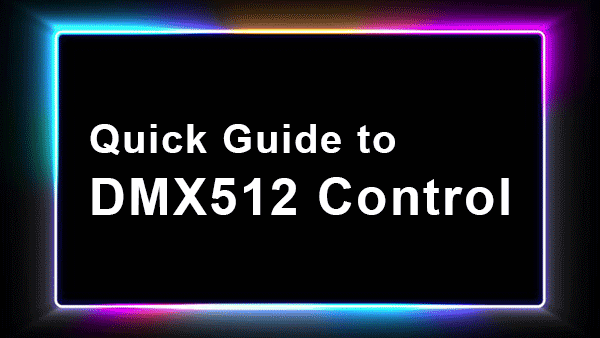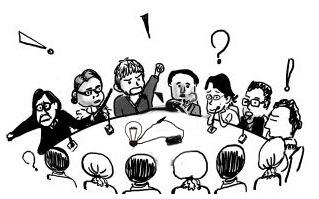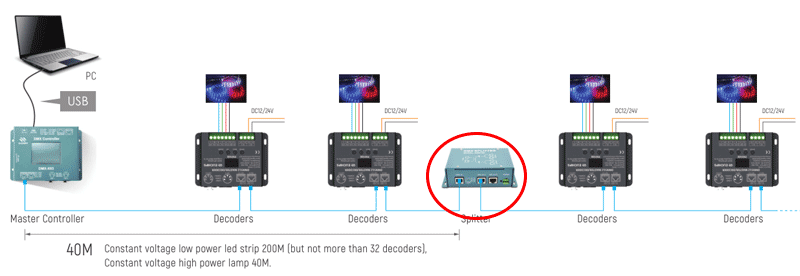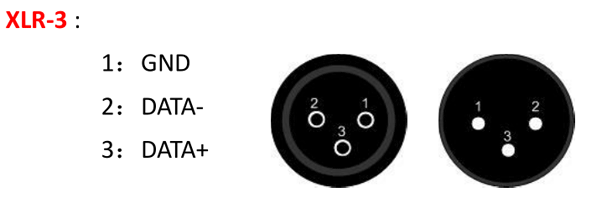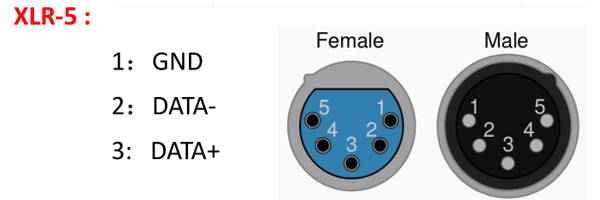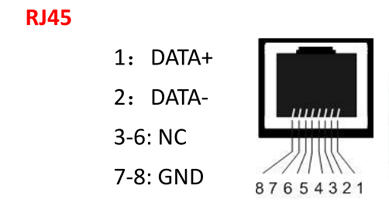The impact of DMX512 on lighting control goes through the past, present, and future, marking a significant shift in the way lighting systems are designed, operated, and experienced. Since its emergence in the 1980s, DMX512 control has revolutionized the lighting industry by providing a standardized protocol for controlling lighting fixtures, overcoming the challenges posed by proprietary systems and incompatible protocols. In the past, DMX512 addressed the fragmentation and inefficiencies inherent in pre-existing lighting control methods, laying the groundwork for a new era of creativity and innovation in lighting design. Today, DMX512 remains the backbone of professional lighting applications, enabling precise control, seamless integration, and dynamic effects across a wide range of industries and settings. Looking to the future, DMX512 continues to evolve alongside advancements in technology, sustainability, and industry practices, shaping the trajectory of lighting control and paving the way for new possibilities in immersive experiences and environmental consciousness.
History of DMX512
Before the invention of DMX 512, stage lighting manufacturers relied on a multitude of proprietary cable types, each incompatible with the others. This lack of standardization led to considerable frustration and redundancy within the industry.
1. 1986: Development: DMX512 was developed by the United States Institute for Theatre Technology (USITT) as a standardized protocol for controlling lighting dimmers.
2. 1990: Introduction of DMX512/1990: The DMX512/1990 standard was introduced, specifying the electrical and mechanical characteristics of the protocol. It allowed for the control of up to 512 channels of lighting data over a single cable.
3. Rapid Adoption: DMX512 quickly gained popularity in the entertainment industry due to its simplicity, reliability, and flexibility.
4. Evolution and Revisions: Over the years, the DMX512 protocol saw several revisions and updates to improve performance, address compatibility issues, and support newer lighting fixtures and effects.
5. Legacy Use: Despite the emergence of newer protocols, DMX512 remains widely used in the entertainment industry for controlling lighting and special effects equipment.
6. Continued Support: Many lighting fixtures, control consoles, and other equipment still rely on DMX512 for communication, and it continues to be supported by manufacturers and industry persons.
7. Industry Standard: DMX512 has become the standard for lighting control in theaters, concert venues, nightclubs, and other entertainment spaces.
8. Global Impact: DMX512′s standardized approach to lighting control has had a significant impact globally, providing a common language for lighting professionals to communicate and collaborate effectively.
9. Integration with New Technologies: While newer protocols like Art-Net and sACN have emerged, DMX512 remains relevant and continues to be integrated with newer technologies to meet the evolving needs of the entertainment industry.
10. Foundation for Innovation: The widespread adoption of DMX512 has laid the foundation for innovation in lighting design and control, enabling lighting professionals to create immersive and dynamic experiences for audiences worldwide.
What is DMX512?
DMX512 is a standardized protocol used in the entertainment industry for controlling lighting and special effects equipment. It stands for Digital Multiplex 512, indicating its ability to control up to 512 channels of lighting data over a single cable. DMX512 provides a common language for lighting controllers to communicate with lighting fixtures, allowing for precise control over brightness, color, movement, and other parameters. This protocol has become the industry standard for lighting control in theaters, concert venues, nightclubs, and other entertainment spaces due to its simplicity, reliability, and flexibility.
What is 512 Channels?
The “512 channels” in DMX512 refers to the number of individual control parameters that can be addressed and manipulated within the protocol.
1. Individual Control Parameters: Each channel represents a specific attribute of a lighting fixture or effect, such as brightness, color, pan, tilt, strobe, or other effects. For example, a simple RGB LED fixture might have three channels—one for red, one for green, and one for blue—allowing precise control over each color component.
2. Range of Values: Each channel can typically accept values between 0 and 255, representing the full range of control for that parameter. For example, a channel controlling brightness might have a value of 0 for off and 255 for full intensity.
3. Total Control: With 512 channels available, DMX512 provides extensive control over lighting setups, allowing lighting designers to create intricate and dynamic effects by adjusting multiple parameters across multiple fixtures simultaneously.
4. Fixture Compatibility: Different types of lighting fixtures require varying numbers of channels to control their full range of functions. Some fixtures may only require a few channels for basic control, while others, such as moving lights or pixel-mapped LED arrays, may utilize dozens of channels or more.
5. Channel Assignment: Channels are typically assigned sequentially, with each fixture or effect occupying a block of channels corresponding to its number of control parameters. For example, a fixture with five control parameters might occupy channels 1 through 5, while the next fixture would begin at channel 6.
6. DMX Universes: In larger lighting setups, multiple DMX512 universes may be used to accommodate more than 512 channels. Each universe operates independently, with its own set of 512 channels, allowing for virtually unlimited scalability in lighting control systems.
Overall, the 512 channels provided by DMX512 offer lighting designers a powerful tool for creating dynamic and customizable lighting effects in a wide range of entertainment applications.
When to use DMX512?
You can use DMX512 to dim single color, color-temperature, RGB, RGBW, RGBWY, etc. And DMX512 is the ideal choice when a lighting control system demands:
1. Centralized Control: When you need to manage multiple lighting fixtures from a single control source, DMX512 is the go-to protocol. It allows you to coordinate and synchronize the operation of various fixtures, ensuring a cohesive lighting design.
2. Smooth Fades: DMX512 supports smooth and seamless fades between different lighting states. Whether you’re transitioning from one color to another, adjusting brightness levels, or creating intricate lighting effects, DMX512 ensures that transitions are smooth and visually appealing.
3. Real-Time Performance: DMX512 offers real-time control capabilities, allowing lighting operators to make instantaneous adjustments in response to dynamic changes in the environment or performance. Whether it’s reacting to live music, adjusting lighting cues on the fly, or responding to audience participation, DMX512 provides the responsiveness needed for real-time performance.
4. Complex Lighting Setups: DMX512 is ideal for managing complex lighting setups that involve multiple fixtures with varying control parameters. Whether you’re controlling conventional fixtures, LED lights, moving heads, or special effects devices, DMX512 provides a standardized protocol for coordinating their operation.
5. Dynamic Environments: In environments where lighting needs to adapt quickly to changing conditions or cues, DMX512 shines. This could include live performances, events with interactive elements, or installations where lighting effects need to respond to real-time inputs.
6. Precision Control: DMX512 offers precise control over individual lighting parameters, allowing you to fine-tune brightness levels, color mixing, pan/tilt movements, and more. This level of control is essential for achieving the desired lighting effects and creating immersive experiences.
7. Integration with Lighting Controllers: DMX512 is compatible with a wide range of lighting control consoles, software, and hardware interfaces, making it easy to integrate into existing lighting systems. Whether you’re using a basic lighting console or a sophisticated lighting control system, DMX512 provides a common language for communication.
8. Scalability: DMX512 is scalable, allowing you to expand your lighting system by adding more fixtures, universes, or control zones as needed. This scalability makes it suitable for applications of all sizes, from small theaters and clubs to large-scale productions and installations.
9. Reliability: DMX512 is known for its reliability and robustness, ensuring consistent performance even in challenging environments. Whether you’re operating in noisy electrical environments, dealing with interference, or facing other technical challenges, DMX512 provides a stable platform for lighting control.
DMX512 is used in various professional and entertainment lighting applications where precise control over lighting fixtures and special effects is required. Here are some common scenarios where DMX512 is used:
1. Theater Productions: DMX512 is extensively used in theatrical productions for controlling stage lighting, including spotlights, floodlights, moving lights, and color-changing fixtures. Lighting designers rely on DMX512 to create dynamic and atmospheric lighting effects that enhance the mood and atmosphere of the performance.
2. Concerts and Live Events: In concert venues, music festivals, and other live events, DMX512 is used to control stage lighting, video walls, pyrotechnics, and other special effects. Lighting operators can synchronize lighting cues with music and visuals to create immersive experiences for audiences.
3. Nightclubs and Bars: DMX512 is a staple in nightclubs, bars, and entertainment venues where dynamic lighting effects are integral to the atmosphere. DJs and lighting operators use DMX512 to control LED panels, moving lights, lasers, and other lighting fixtures to enhance the energy and ambiance of the space.
4. Architectural Lighting: DMX512 is also used in architectural lighting applications, such as lighting installations in museums, theme parks, retail stores, and architectural landmarks. Designers use DMX512 to create dynamic lighting displays that highlight architectural features, illuminate outdoor spaces, and enhance visitor experiences.
5. Film and Television Production: In film and television production, DMX512 is used to control studio lighting, set lighting, and special effects lighting. Lighting directors and cinematographers rely on DMX512 to create specific lighting setups that complement the mood and tone of a scene.
6. Theme Parks and Attractions: Theme parks and attractions often use DMX512 to control lighting and special effects in ride experiences, immersive attractions, and themed environments. Lighting designers can synchronize lighting effects with ride movements and audio cues to create compelling and memorable guest experiences.
Overall, DMX512 is used in a wide range of applications where precise and synchronized control over lighting and effects is essential for creating immersive and impactful experiences.
Wiring for DMX512
Wiring for DMX512 is relatively straightforward, but it’s essential to follow best practices to ensure reliable communication between your lighting fixtures and control equipment. Here’s an overview of how to wire a DMX512 system:

DMX Cable: Use a shielded twisted pair cable specifically designed for DMX512. The most common type of cable used is a 5-pin XLR cable, although some fixtures and controllers may use 3-pin XLR connectors. Make sure to use cables with sufficient length for your setup, avoiding excessive coiling or bundling that could cause signal degradation.
Termination: Termination is crucial for preventing signal reflections and ensuring stable communication within your DMX512 network. Terminate both ends of your DMX cable run with a 120Ω terminator. This is typically done by connecting a terminator plug or resistor across pins 2 and 3 of the last fixture or device in the chain.
Daisy-Chaining: Connect your DMX fixtures in a daisy-chain configuration, where each fixture is connected to the next in a linear sequence. Start with your DMX controller or console, then connect the output of the controller to the input of the first fixture. Continue daisy-chaining additional fixtures in the order you want them to receive DMX data.
Maximum: We Euchips strongly recommended to use a repeater/booster after a maximum of 32 unit loads in a DMX network. It is crucial to ensure that the total length of the cable between the controller and the last driver remains below 1600″.
Addressing: Assign a unique DMX address to each fixture in your system to control its behavior independently. This is typically done using DIP switches or digital menus on the fixture itself. Ensure that each fixture’s DMX address matches its position in the daisy chain and corresponds to the channels you want to control.
Power: Provide power to your DMX fixtures according to the manufacturer’s specifications. Most fixtures require both DMX signal and power, so make sure to connect them to a reliable power source using appropriate cables and connectors.
Signal Integrity: Minimize sources of interference that could disrupt DMX communication. Keep DMX cables away from power cables, fluorescent lights, dimmer racks, and other sources of electrical noise. Use high-quality cables and connectors to maintain signal integrity throughout your DMX system.
Testing and Troubleshooting: Once your DMX system is wired, thoroughly test each fixture to ensure it responds correctly to DMX control signals. Use a DMX tester or diagnostic tool to verify signal continuity, address settings, and proper fixture operation. Troubleshoot any issues by checking cable connections, addressing, termination, and signal routing.
By following these guidelines for wiring your DMX512 system, you can ensure reliable communication and seamless control of your lighting fixtures for a wide range of professional and entertainment applications.
Connectors for DMX512
DMX512 uses specific types of connectors for transmitting data between lighting fixtures, controllers, and other DMX-compatible devices. The two most common types of connectors used in DMX512 installations are:
XLR Connectors:
3-pin XLR: This is the most common type of connector used for DMX512. It features three pins (pin 1 for ground, pin 2 for data negative, and pin 3 for data positive) and is widely used in lighting fixtures, controllers, and DMX cables.
5-pin XLR: While less common in DMX512 installations, 5-pin XLR connectors are sometimes used, particularly in professional audio and lighting equipment. In DMX512 applications, the extra pins are typically unused, and only three pins (pin 1 for ground, pin 2 for data negative, and pin 3 for data positive) are utilized.
RJ45 Connectors:
Ethernet (RJ45): Some DMX512 devices, especially those with network connectivity or using Ethernet-based DMX protocols like Art-Net or sACN, may utilize RJ45 connectors for data transmission. These connectors are familiar with computer networking and are used with Ethernet cables.
When selecting connectors for your DMX512 setup, it’s crucial to ensure compatibility with your devices and cables. Here are some considerations:
Device Compatibility: Check the specifications of your lighting fixtures, controllers, and other DMX-compatible devices to determine which type of connector they use (3-pin XLR, 5-pin XLR, or RJ45).
Cable Type: Choose DMX cables with connectors that match the connectors on your devices. For example, if your fixtures and controller use 3-pin XLR connectors, use DMX cables with 3-pin XLR connectors on both ends.
Interoperability: Ensure that all components of your DMX512 system, including fixtures, controllers, cables, and connectors, are compatible and interoperable to avoid compatibility issues or signal degradation.
Reliability and Durability: Select high-quality connectors that provide secure connections and reliable data transmission, especially in demanding environments such as live events, theaters, and concert venues.
By selecting the appropriate connectors and cables for your DMX512 setup and ensuring compatibility and reliability, you can create a robust and efficient lighting control system for your professional or entertainment application.
Pros and Cons of DMX512
Pros:
Standardization: DMX512 provides a standardized protocol for controlling lighting and special effects equipment in the entertainment industry. This standardization ensures compatibility between different manufacturers’ devices, allowing for interoperability and ease of integration.
Versatility: DMX512 supports a wide range of lighting fixtures and effects, including conventional fixtures, LED lights, moving heads, strobes, and more. This versatility makes it suitable for various professional and entertainment lighting applications, from theaters and concerts to nightclubs and architectural installations.
Precise Control: DMX512 offers precise control over individual lighting parameters, allowing for fine-tuning of brightness, color, movement, and other effects. Lighting designers can create intricate and dynamic lighting effects by adjusting multiple parameters across multiple fixtures simultaneously.
Real-time Performance: DMX512 provides real-time control capabilities, enabling lighting operators to make instantaneous adjustments in response to dynamic changes in the environment or performance. This responsiveness is essential for live events, concerts, and other applications where timing and synchronization are critical.
Scalability: DMX512 is scalable, allowing for the expansion of lighting systems by adding more fixtures, universes, or control zones as needed. This scalability makes it suitable for applications of all sizes, from small-scale productions to large-scale installations.
Cons:
Limited Channel Capacity: The 512-channel limit of DMX512 can be restrictive in large-scale lighting setups with numerous fixtures and complex control requirements. In such cases, multiple DMX universes may be required, adding complexity to the system.
Cable Length Limitations: DMX512 cables have a limited transmission range, typically around 1,200 feet (approximately 365 meters) without the use of signal boosters or repeaters. Longer cable runs may experience signal degradation, resulting in unreliable communication between fixtures and controllers.
Interference and Noise: DMX512 communication can be susceptible to interference and noise from electrical sources, such as power cables, dimmer racks, and fluorescent lights. Proper cable routing, shielding, and grounding are essential to minimize interference and ensure reliable signal transmission.
Setup and Configuration Complexity: Configuring DMX512 systems, including addressing fixtures, patching channels, and troubleshooting connectivity issues, can be complex and time-consuming, especially for novice users. Proper training and familiarity with DMX512 protocols are essential for efficient system setup and operation.
Compatibility with New Technologies: While DMX512 remains widely used in the entertainment industry, newer technologies such as Ethernet-based protocols (e.g., Art-Net, sACN) are gaining popularity for lighting control. Integrating DMX512 with these newer technologies may require additional hardware or software interfaces, adding complexity to the system architecture.
Overall, while DMX512 offers standardized, versatile, and precise control capabilities for lighting and special effects, it also presents limitations and challenges that users must consider when designing and implementing lighting systems.
The Impact of DMX512 on Lighting Control: Past, Present, and Future
Here’s an exploration of the impact of DMX512 on lighting control, spanning its past, present, and future:
Historical Significance: DMX512 has played a transformative role in lighting control since its development in the 1980s. Before its introduction, the lighting industry grappled with proprietary protocols and incompatible systems, leading to inefficiencies and limitations in lighting design and operation.
Standardization and Interoperability: The introduction of DMX512 brought about a paradigm shift by providing a standardized protocol for controlling lighting fixtures. This allowed for interoperability between different manufacturers’ devices, enabling lighting designers to create cohesive and synchronized lighting setups.
Revolutionizing Stage Lighting: DMX512 revolutionized stage lighting by offering precise control over individual fixtures and parameters. Lighting designers gained the ability to create dynamic and immersive lighting effects, enhancing the visual experience for audiences in theaters, concerts, and other live events.
Advancements in Technology: Over the years, DMX512 has evolved to keep pace with technological advancements in the lighting industry. Revisions and updates to the protocol have improved performance, expanded capabilities, and addressed compatibility issues with newer lighting fixtures and effects.
Global Adoption and Standardization: DMX512 has become the standard for lighting control in the entertainment industry worldwide. Its widespread adoption has facilitated collaboration and communication among lighting professionals, leading to the development of innovative lighting designs and techniques.
Present-Day Applications: In the present day, DMX512 continues to play a central role in professional lighting applications across various industries. It is used in theaters, concert venues, nightclubs, architectural installations, film and television production, theme parks, and more, demonstrating its versatility and reliability.
Challenges and Limitations: Despite its many benefits, DMX512 is not without its challenges. Limitations such as channel capacity, cable length restrictions, and susceptibility to interference pose constraints on larger and more complex lighting setups. However, these challenges can often be mitigated through proper system design and implementation.
Future Trends and Innovations: Looking ahead, DMX512 is poised to continue evolving alongside advancements in lighting technology. Integration with emerging technologies such as the Internet of Things (IoT), wireless communication, and smart lighting systems holds the potential to further enhance the capabilities and flexibility of DMX512-based lighting control.
Sustainability and Energy Efficiency: As concerns about sustainability and energy efficiency grow, DMX512 may also play a role in driving eco-friendly lighting solutions. Efforts to optimize lighting control systems for energy savings and environmental impact are likely to shape the future of DMX512 applications.
Industry Collaboration and Education: Collaboration between industry stakeholders, including manufacturers, designers, technicians, and educators, will be essential for advancing the use of DMX512 in lighting control. Continued education and training initiatives will empower professionals to leverage DMX512 effectively and innovatively.
Conclusion
In summary, DMX512 has had a profound impact on lighting control, shaping the past, present, and future of the industry. Its standardization, versatility, and reliability have made it indispensable in a wide range of professional lighting applications, with ongoing advancements and innovations poised to drive its continued relevance and evolution in the years to come.
If you still don’t know how to use DMX512 control, please don’t worry, Euchips can help you. Euchips is a professional manufacturer focusing on DMX controller, DMX decoder, DMX driver for perfect lighting. Why not contact us now! sales@euchips.com
 |
Hello, dear valued customers,
This is Almay Lee from Euchips. I have been in LED dimming industry for more than 10 years. Please feel free to contact us. We are happy to provide you with the best service and products. Email: almay@euchipsonline.com | Wechat: almayli |
Post time: May-09-2024

